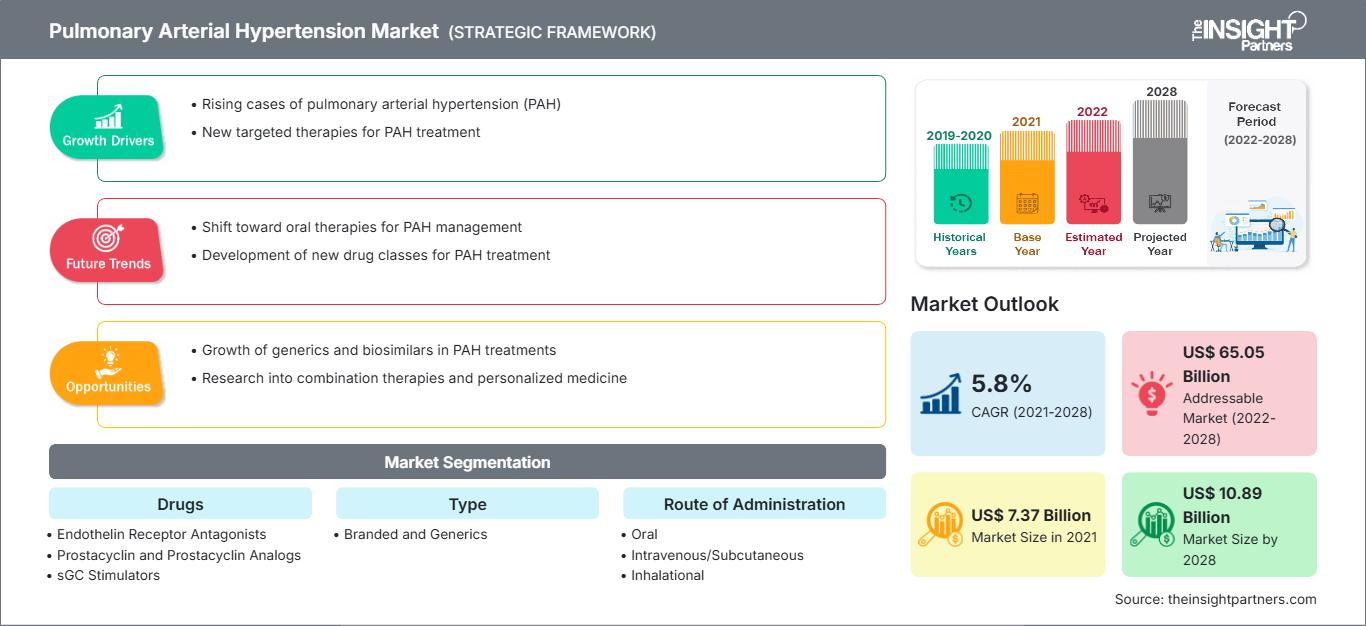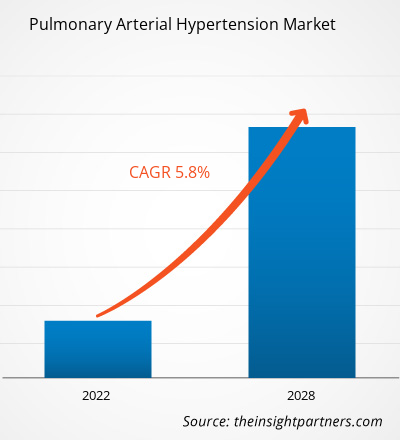Der Markt für pulmonale arterielle Hypertonie soll von 7.369,89 Millionen US-Dollar im Jahr 2021 auf 10.889,08 Millionen US-Dollar im Jahr 2028 wachsen; von 2022 bis 2028 wird eine durchschnittliche jährliche Wachstumsrate (CAGR) von 5,8 % erwartet.
Der Markt für pulmonale arterielle Hypertonie ist nach Medikament, Art, Verabreichungsweg, Vertriebskanal und geografischer Lage segmentiert. Der Bericht bietet Einblicke und eine detaillierte Analyse des Marktes für pulmonale arterielle Hypertonie und hebt dabei verschiedene Parameter wie Dynamik, Trends und Marktchancen sowie die Wettbewerbslandschaft führender Marktteilnehmer in verschiedenen Regionen hervor. Er enthält außerdem eine Analyse der Auswirkungen der COVID-19-Pandemie auf den Markt für pulmonale arterielle Hypertonie in den Regionen.
Passen Sie diesen Bericht Ihren Anforderungen an
Sie erhalten kostenlos Anpassungen an jedem Bericht, einschließlich Teilen dieses Berichts oder einer Analyse auf Länderebene, eines Excel-Datenpakets sowie tolle Angebote und Rabatte für Start-ups und Universitäten.
Markt für pulmonale arterielle Hypertonie: Strategische Einblicke

-
Holen Sie sich die wichtigsten Markttrends aus diesem Bericht.Dieses KOSTENLOSE Beispiel umfasst Datenanalysen, die von Markttrends bis hin zu Schätzungen und Prognosen reichen.
Markteinblicke
Steigende Zulassungen von Medikamenten gegen pulmonale arterielle Hypertonie treiben Marktwachstum an
- Im September 2022 erhielt Toray Industries, Inc. von der chinesischen National Medical Products Administration (NMPA) die Zulassung für Careload-Tabletten zur Behandlung von pulmonaler arterieller Hypertonie (PAH). Careload ist eine oral verabreichte Retardformulierung von Beraprost-Natrium, einem Prostacyclin-Derivat (PGI2).
- Im Mai 2022 erhielt die United Therapeutic Corporation von der US-amerikanischen Food and Drug Administration (FDA) die Zulassung für Tyvaso DPI (Treprostinil)-Inhalationspulver zur Behandlung von pulmonaler Hypertonie in Verbindung mit interstitieller Lungenerkrankung (PH-ILD; WHO-Gruppe 3) und pulmonaler arterieller Hypertonie (PAH; WHO-Gruppe 1) zur Verbesserung der körperlichen Leistungsfähigkeit.
- Im November 2021 erteilte die US-amerikanische FDA die vorläufige Zulassung für Yutrepia (Treprostinil)-Inhalationspulver. Yutrepia ist zur Behandlung von PAH zur Verbesserung der körperlichen Leistungsfähigkeit bei erwachsenen Patienten mit Symptomen der Funktionsklasse II-III der New York Heart Association (NYHA) indiziert.
- Im Juli 2021 erhielten die Janssen Pharmaceutical Companies of Johnson & Johnson die FDA-Zulassung für UPTRAVI (Selexipag) zur intravenösen (IV) Injektion zur Behandlung von PAH; WHO-Gruppe I bei erwachsenen Patienten der WHO-Funktionsklasse (FC) II–III, die vorübergehend keine orale Therapie einnehmen können.
- Im August 2021 gab Aerami Therapeutics, Inc. bekannt, dass die FDA dem Unternehmen den Orphan-Drug-Status für Imatinib zur Behandlung von PAH-Patienten erteilt hat. AER– 901, ein Kandidat für eine Kombination aus Medikament und Gerät für inhaliertes Imatinib zur Behandlung von PAH, befindet sich in einer Phase-1-Studie, deren Abschluss für Ende 2021 geplant ist.
Die steigenden Zulassungen von Medikamenten gegen pulmonale arterielle Hypertonie weltweit fördern das Wachstum des Marktes für pulmonale arterielle Hypertonie.
Medikamentenbasierte Erkenntnisse
Basierend auf dem Medikament ist der Markt für pulmonale arterielle Hypertonie in Endothelin-Rezeptor-Antagonisten (ERAs), Prostacyclin und Prostacyclin-Analoga, sGC-Stimulatoren und PDE-5-Teststreifen unterteilt. Das Segment Prostacyclin und Prostacyclin-Analoga hatte 2021 den größten Marktanteil und wird voraussichtlich zwischen 2022 und 2028 die höchste durchschnittliche jährliche Wachstumsrate verzeichnen. Prostacyclin ist ein kleines Lipid-Eicosanoid-Molekül, auch bekannt als Prostaglandin I-2 (PGI-2), das von Endothelzellen produziert wird und lokal wirkt, indem es die Thrombozytenaktivierung hemmt und eine Vasodilatation verursacht. Prostacyclin erweitert die Blutgefäße, verbessert den Blutfluss, indem es die Proliferation glatter Gefäßmuskelzellen verhindert, und verhindert die Blutgerinnung, indem es die Thrombozytenaggregation hemmt. Prostacyclin-Analoga wurden als Therapien für PAH entwickelt. PAH-Prostacyclin-Analoga sind synthetische Formen von Prostacyclin, einer natürlichen, im Körper produzierten Substanz. Patienten mit PAH haben tendenziell einen erniedrigten Prostacyclinspiegel, was zu Blutgefäßverengung und Bluthochdruck führt. PAH-Prostacyclin-Analoga ergänzen den Bedarf und imitieren die Wirkung von natürlichem Prostacyclin, um die pulmonale Hypertonie zu senken und die damit verbundenen Symptome zu lindern.
Typbasierte Erkenntnisse
Basierend auf dem Typ ist der Markt für pulmonale arterielle Hypertonie in Marken- und Generikaprodukte unterteilt. Das Markensegment hatte 2021 einen größeren Marktanteil und dürfte im Prognosezeitraum eine höhere durchschnittliche jährliche Wachstumsrate (CAGR) verzeichnen. Ein Pharmaunternehmen verkauft ein Markenmedikament unter einem bestimmten Namen oder Warenzeichen, das durch ein Patent geschützt ist. Markenmedikamente können verschreibungspflichtig oder rezeptfrei erhältlich sein. Riociguat, das unter dem Markennamen Adempas verkauft wird, ist Bayers Medikamentenstimulator der löslichen Guanylatcyclase. Es wird zur Behandlung von zwei Formen der pulmonalen Hypertonie eingesetzt: chronisch thromboembolischer pulmonaler Hypertonie und pulmonaler arterieller Hypertonie.
Erkenntnisse zum Verabreichungsweg
Basierend auf dem Verabreichungsweg ist der Markt für pulmonale arterielle Hypertonie in oral, intravenös/subkutan und inhalativ unterteilt. Das orale Segment hatte 2021 den größten Marktanteil und wird im Prognosezeitraum voraussichtlich die höchste CAGR verzeichnen. Zu den oral verabreichten Wirkstoffen zur Behandlung von symptomatischer, mittelschwerer bis schwerer PAH gehören Sildenafil und die Endothelin(ET)-Rezeptorantagonisten (ERAs) Bosentan und Sitaxentan (Sitaxsentan) sowie Abrisentan, ein oraler ET(A)-Rezeptor-selektiver ERA mit höherer ET-Rezeptoraffinität als Bosentan. Darüber hinaus gibt es neue orale Medikamente zur Behandlung von PAH, darunter Macitentan, Riociguat und Treprostinil. Ambrisentan ist ein Endothelin-Rezeptor-Antagonist, der zur Behandlung von PAH (WHO-Gruppe 1) und zur Verzögerung einer klinischen Verschlechterung indiziert ist. In Kombination mit Tadalafil soll Ambrisentan das Risiko eines Fortschreitens der Krankheit und eines Krankenhausaufenthalts bei Verschlechterung der PAH verringern und die körperliche Leistungsfähigkeit verbessern.
Einblicke nach Vertriebskanälen
Basierend auf den Vertriebskanälen ist der Markt für pulmonale arterielle Hypertonie in Krankenhausapotheken und -kliniken, Online-Apotheken und Apotheken im Einzelhandel unterteilt. Das Segment der Krankenhausapotheken und -kliniken hatte 2021 den größten Marktanteil und wird im Prognosezeitraum voraussichtlich die höchste durchschnittliche jährliche Wachstumsrate verzeichnen. Krankenhausapotheken sind bestrebt, das Medikamentenmanagement und die pharmazeutische Versorgung der Patienten im Krankenhausumfeld kontinuierlich auf höchstem Niveau zu halten und zu verbessern. Apotheker in diesem Bereich sind für die Abgabe von Medikamenten, Qualitätsprüfungen, die Formulierung und Neuformulierung von Darreichungsformen, die Überwachung und Berichterstattung zur Arzneimittelsicherheit sowie die Erstellung von Medikamentenbudgets verantwortlich.
Die Akteure auf dem Markt für pulmonale arterielle Hypertonie verfolgen organische Strategien wie Produkteinführung und -erweiterung, um ihre Präsenz und ihr Produktportfolio weltweit zu erweitern und die wachsende Nachfrage zu decken. Anorganische Wachstumsstrategien, die auf dem Markt zu beobachten sind, sind Partnerschaften und Kooperationen. Diese Wachstumsstrategien haben es den Marktteilnehmern ermöglicht, ihre Geschäfte auszubauen und ihre geografische Präsenz zu verbessern. Darüber hinaus tragen Akquisitionen, Partnerschaften und andere Wachstumsstrategien dazu bei, den Kundenstamm des Unternehmens zu stärken und sein Produktportfolio zu erweitern.
- Im September 2022 brachte Lupin Sildenafil zur oralen Suspension mit der Zulassung der US-amerikanischen FDA auf den US-Markt. Das Medikament ist eine generische Version von Revatio zur oralen Suspension von Viatris Specialty LLC. Sildenafil zur oralen Suspension behandelt PAH.
- Im Februar 2021 unterzeichnete Aerami Therapeutics, Inc. eine exklusive Lizenz- und Entwicklungsvereinbarung mit Hangzhou Chance Pharmaceuticals Co. Ltd. (Chance) zur Entwicklung und Vermarktung des Arzneimittel-Geräte-Kombinationsproduktkandidaten („AER-901“) von Aerami zur Behandlung von PAH in Festlandchina, Hongkong, Macau und Taiwan. Im Rahmen der Vereinbarung ist Chance für die Gesamtentwicklung und Vermarktung von AER-901 für PAH in diesem Gebiet verantwortlich.
Pulmonale arterielle Hypertonie
Regionale Einblicke in den Markt für pulmonale arterielle HypertonieDie Analysten von The Insight Partners haben die regionalen Trends und Faktoren, die den Markt für pulmonale arterielle Hypertonie im Prognosezeitraum beeinflussen, ausführlich erläutert. In diesem Abschnitt werden auch die Marktsegmente und die geografische Lage in Nordamerika, Europa, dem asiatisch-pazifischen Raum, dem Nahen Osten und Afrika sowie Süd- und Mittelamerika erörtert.
Umfang des Marktberichts zur pulmonalen arteriellen Hypertonie
| Berichtsattribut | Einzelheiten |
|---|---|
| Marktgröße in 2021 | US$ 7.37 Billion |
| Marktgröße nach 2028 | US$ 10.89 Billion |
| Globale CAGR (2021 - 2028) | 5.8% |
| Historische Daten | 2019-2020 |
| Prognosezeitraum | 2022-2028 |
| Abgedeckte Segmente |
By Medikamente
|
| Abgedeckte Regionen und Länder |
Nordamerika
|
| Marktführer und wichtige Unternehmensprofile |
|
Dichte der Marktteilnehmer für pulmonale arterielle Hypertonie: Verständnis ihrer Auswirkungen auf die Geschäftsdynamik
Der Markt für pulmonale arterielle Hypertonie wächst rasant. Die steigende Nachfrage der Endverbraucher ist auf Faktoren wie veränderte Verbraucherpräferenzen, technologische Fortschritte und ein stärkeres Bewusstsein für die Produktvorteile zurückzuführen. Mit der steigenden Nachfrage erweitern Unternehmen ihr Angebot, entwickeln Innovationen, um den Bedürfnissen der Verbraucher gerecht zu werden, und nutzen neue Trends, was das Marktwachstum weiter ankurbelt.

- Holen Sie sich die Markt für pulmonale arterielle Hypertonie Übersicht der wichtigsten Akteure
Unternehmensprofile
- Johnson & Johnson
- Gilead Sciences Inc
- United Therapeutics Corp
- Bayer AG
- Aerami Therapeutics Holdings Inc
- Novartis AG
- GSK Plc
- Lupin Ltd
- Pfizer Inc
- Teva Pharmaceutical Industries Ltd.
- Historische Analyse (2 Jahre), Basisjahr, Prognose (7 Jahre) mit CAGR
- PEST- und SWOT-Analyse
- Marktgröße Wert/Volumen – Global, Regional, Land
- Branchen- und Wettbewerbslandschaft
- Excel-Datensatz
Aktuelle Berichte
Erfahrungsberichte
Grund zum Kauf
- Fundierte Entscheidungsfindung
- Marktdynamik verstehen
- Wettbewerbsanalyse
- Kundeneinblicke
- Marktprognosen
- Risikominimierung
- Strategische Planung
- Investitionsbegründung
- Identifizierung neuer Märkte
- Verbesserung von Marketingstrategien
- Steigerung der Betriebseffizienz
- Anpassung an regulatorische Trends






















 Kostenlose Probe anfordern für - Markt für pulmonale arterielle Hypertonie
Kostenlose Probe anfordern für - Markt für pulmonale arterielle Hypertonie